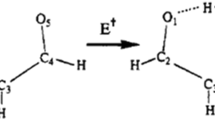Abstract
Of the many subtle protein-cofactor interactions which facilitate oxidative catalysis by heme enzymes, the role of the axial ligand has for some time appeared to be fairly well understood. Recent studies from several laboratories, however, have provided good reason to reemphasize the importance of secondary interactions between the axial ligand and protein, as the results suggest that simple ligand identity is neither necessary nor sufficient for function. It has been widely proposed that the strong hydrogen bond between a proximal carboxylate and the histidine ligand of peroxidases assists O–O bond heterolysis and stabilizes the Fe(IV)=O center that is produced. Recent replacements of the axial ligand in a number of heme proteins have produced a few surprises, suggesting that the subtle interactions between the ligand and protein may in some cases be more important than the actual identity of the ligand.
Similar content being viewed by others
Author information
Authors and Affiliations
Additional information
Received and accepted: 7 May 1996
Rights and permissions
About this article
Cite this article
Goodin, D. When an amide is more like histidine than imidazole: the role of axial ligands in heme catalysis. JBIC 1, 360–363 (1996). https://doi.org/10.1007/s007750050065
Issue Date:
DOI: https://doi.org/10.1007/s007750050065




